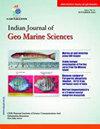法老墨鱼(Sepia pharaonis, Ehrenberg, 1831)的搁浅卵孵育生产和Thoothukudi海岸沿岸的海洋牧场
IF 0.5
4区 地球科学
Q4 Earth and Planetary Sciences
引用次数: 0
摘要
在Thoothukudi区的各个登陆中心收集了意外缠绕和搁浅的法老棕鲷鱼卵团。将搁浅的鱼卵群在中国海洋生物资源研究所图蒂科林研究中心软体鱼孵化场孵化、孵化并进行幼虫饲养。渔网卵的平均孵化率为95%。法老沙蚕第1天幼虫大小为5.46±0.06 mm,第60天平均体长40.10±1.15 mm,体重9.6±0.20 g,平均成活率为70%。最大体重增加(%)出现在20 - 40天。法老沙蚕幼虫以适当的活饲料喂养至50天,之后以死鱼、死虾为食。培养第180天转化为平均体长137.4±8.08 mm,体重229.7±21.54 g的亲鱼。在孵化场,第167天首次捕获产卵,雌鱼产卵数量在46 - 118个之间。然而,圈养繁殖的卵群未能孵化出来。因此,需要通过开发营养改良的种鱼日粮来完善孵化技术,以保证更好的孵化。在2016年至2018年期间,共有8400只孵化场饲养了60天大的S. pharaonis幼鱼,进入了Tuticorin海岸的渔场。海洋牧场活动对补充自然种群的生物学意义有待进一步研究和评价。本文章由计算机程序翻译,如有差异,请以英文原文为准。
Hatchery production of juveniles of pharaoh cuttlefish, Sepia pharaonis (Ehrenberg, 1831) from stranded eggs and sea ranching along the Thoothukudi coast
Accidentally entangled and stranded egg masses of Sepia pharaonis in fishing gears were collected from various landing centres of Thoothukudi district. The stranded egg masses were incubated, hatched and larval rearing was carried out at the Molluscan Fish Hatchery of Tuticorin Research Centre of CMFRI. The average hatching rate of S. pharaonis was 95 % for the eggs collected from the fishing nets. The size of day 1 paralarvae of S. pharaonis was 5.46±0.06 mm and reached the average size of 40.10±1.15 mm length and 9.6±0.20 g weight on day 60 with the average survival rate of 70 %. Maximum weight gain (%) was noticed between 20 – 40 days. The paralarvae of S. pharaonis fed with suitable live feeds until 50 days, after which fed with dead fish and shrimp. The juveniles were transformed as broodstock with an average length of 137.4±8.08 mm and weight of 229.7±21.54 g on 180 th day of culture. In the hatchery, the first captive spawning was witnessed on 167 th day and the eggs laid by the females ranged from 46 – 118. However, the captive bred egg masses failed to hatch out. Therefore, the hatchery technology needs to be perfected through the development of nutritionally improved broodstock diet to ensure better hatching. During the years 2016 – 2018, altogether 8400 numbers of hatchery reared 60 days old juveniles of S. pharaonis were ranched into the fishing grounds off Tuticorin coast. The biological significance of sea ranching activities to replenish the natural stocks requires further research and evaluation.
求助全文
通过发布文献求助,成功后即可免费获取论文全文。
去求助
来源期刊
CiteScore
1.50
自引率
0.00%
发文量
0
审稿时长
1.7 months
期刊介绍:
Started in 1972, this multi-disciplinary journal publishes full papers and short communications. The Indian Journal of Geo-Marine Sciences, issued monthly, is devoted to the publication of communications relating to various facets of research in (i) Marine sciences including marine engineering and marine pollution; (ii) Climate change & (iii) Geosciences i.e. geology, geography and geophysics. IJMS is a multidisciplinary journal in marine sciences and geosciences. Therefore, research and review papers and book reviews of general significance to marine sciences and geosciences which are written clearly and well organized will be given preference.

 求助内容:
求助内容: 应助结果提醒方式:
应助结果提醒方式:


